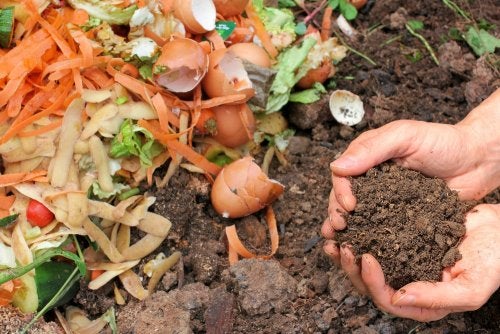Some food residues that contain potassium and calcium can be used to prepare organic fertilizers to nourish the soils. We tell you how to use them to benefit your plants.
There are many ways to make compost to fertilize your garden plants. Although these products can be purchased in multiple commercial places, there are 100% natural ingredients that provide a “plus” of nutrients for the soil.

In fact, they are options that have been used since ancient times in all crops, but were replaced by synthetic fertilizer. The latter, although it nourishes the soil quickly, can cause long-term negative effects, since it ends up depleting it.
Although it is true that the roots of plants do not distinguish between one type of fertilizer and another, those of industrial origin end up creating imbalances. Not only do they decrease the presence of “good” microbes, they kill earthworms.
1. Make organic compost from banana peel.
Banana peel is one of the best ingredients to compost because of its potassium content. This essential mineral is one of the most important nutrients for plants after nitrogen. It is involved in photosynthesis and the formation of resistant tissues. In addition, it helps to revitalize the plants when they decrease their flowering or acquire a dull appearance. The best thing is that they can be used in their natural state or, well, prepared in tea.
Instructions:
- Cut the banana peels into several strips and boil them in a pot of water for 15 minutes.
- After this time, turn off the fire and wait for it to rest.
- Finally, sprinkle the compost around the plant. If you want, you can leave the shells.
2. Organic apple cider vinegar fertilizer.
The acetic acid in apple cider vinegar can help fertilize plants that grow in acidic soils. The absorption of its nutrients helps keep the plant in good condition and prevents its leaves from acquiring a burnt appearance.
Instructions:
- Add a tablespoon of apple cider vinegar to the water for watering the plants and use as usual.
- Repeat its application at least once a month.
3. Make compost with eggshells.
When making an organic compost with eggshells, other natural ingredients are usually used. However, they can also be used on their own, as they contain high doses of calcium and prevent blossom end rot in plants such as tomatoes, peppers, and eggplant.
Instructions:
- Crush several eggshells and insert them into the bottom of your plantations.
- Optionally, dry the shells and turn them into a fine powder using a grinder.
- Then, apply the powder around the plant.
4. Compost from wood ash.
Composting wood ash can help the flowers and fruits of various plants to ripen. This natural element contains high doses of potassium and phosphorus, both necessary for the enrichment of the soil.
On the other hand, it contains substances that repel ants and other types of pests. However, it should be avoided for acidic soil species, as it alters the pH of the soil.
Instructions:
- Take a good amount of wood ash and dilute it in water.
- Next, spread the liquid over the desired plants.
- If you prefer, spread a thin layer of ashes 2 to 3 centimeters away from the stem.
Note: You must check that the ashes do not come from woods compromised with heavy metals or polluting elements. If so, its use can ruin the garden.
5. Organic compost with algae.
One of the organic fertilizers that almost no one knows about is algae. Available both fresh and dried, this natural ingredient contains powerful trace elements that serve as food for the “good” microbes that live in the soil.
Its use keeps the plants looking healthy and prevents them from wilting. In addition, it protects them against some microorganisms that cause diseases.
Instructions:
- Chop up a generous amount of seaweed and add it to a bucket of water.
- Cover the bucket and let the compost sit for 2 to 3 weeks.
- After this time, use the liquid to soak the soil.
- For small plants, just apply 2 cups. If the plant is medium or large, you can spray 4 to 6 cups.


